- Track your orders
- Save your details for express checkout
Home > News and Events > IFOMPT Webinars

IFOMPT hosts up to six webinars per year with the purpose of sharing knowledge and exposing our Member Organisations, Associate Member Organisations and Registered Interest Groups to renowned presenters from around the world. Webinars are attended at a small attendance fee and the income is used to further enhance the objects of IFOMPT. The webinars are recorded and are available a library hosted by APTA on a user-pay basis following the live events -
https://learningcenter.apta.org/IFOMPT
Note that APTA membership is not required to access the webinars, but you do need to set up an APTA ID – there is no cost for that. Simply go to https://learningcenter.apta.org/IFOMPT in order to register. For easy access to the specific recordings you can also click on the link below the photograph of each presenter in the IFOMPT Webinar Hall of Fame once you have an APTA account.
Any recommendations about potental presenters are most welcome and can be sent to admin@ifompt.org.
We have been honoured to have highly respected presenters involved in our webinars and acknowledge their contribution to reaching the IFOMPT objective of sharing knowledge for the advancement of OMPT practice worldwide.


Post professional manual therapy education: A path to reducing burnout - Derek ClewleyBurnout is an increasing challenge in the profession of physical therapy, leading to exhaustion, disengagement, and reduced productivity. This talk will risks and impacts of burnout, and provide strategies for addressing it through professional development. We’ll discuss how continuous learning, skill enhancement, and career growth can be powerful tools for regaining motivation and resilience. Join us for this insightful session and take the first step toward a healthier, more fulfilling professional journey! |

|

|
Reporting guidelines are available for use by authors when writing up the results of musculoskeletal research, including manual therapy and exercise therapy research. However, many publications fail to appropriately report specifics on the methodology used or the interventions provided, which creates potential issues with the actual treatment effects reported. This webinar will highlight the current state of the musculoskeletal literature in relation to reporting and transparency. |
Contextual effects in Orthopedic Manual Physiotherapy – opportunities and implications - Dr Giacomo RossettiniContextual effects are embodied psycho-neurobiological phenomena capable of inducing changes across neurobiological, physical, perceptual, and cognitive levels. These changes are triggered by various contextual factors present in the therapeutic environment, represented by diverse healing rituals and signals (e.g., the clinician’s attributes, the patient’s characteristics, the patient-clinician relationship, treatment features, and the broader healthcare setting).Evidence has shown that contextual effects can influence subjective outcomes in musculoskeletal patients, often through placebo and nocebo mechanisms. A positive context enhances therapeutic outcomes through placebo effects, while a negative context can worsen clinical conditions by inducing nocebo effects. Moving from this premise, the webinar aims to provide a comprehensive overview of contextual effects by examining: Reasons for Interest; Definitions and Dimensions; Mechanisms of Action and Impact on Outcomes; Implications for Practice and Research. |

|

|
Mechanisms Matter: Understanding How Mechanisms Influence Patient Outcomes - Dr Amy McDevittSession Objectives
|
Individualised management of individuals with migraine associated neck pain - Dr Zhiqi LiangAn overview of the current body of literature on physiotherapy management of migraine will be provided, with emphasis on neck treatments and mechanisms relating to neck pain and migraine. Current evidence indicates that patients with neck pain and migraine have different underlying mechanisms. Subgroups with different treatment directions are present. Therefore, this session will discuss on an individualised approach to assessment and management of patients with migraine and neck pain. A case scenario will be discussed to illustrate these concepts. |

|

|
The winds of change: Modernizing manual therapy rationale, application, and education - Dr Damian KeterWhere is manual therapy going looking forward based on the changes we are seeing within the profession? What manual therapy is and perhaps is not doing when we put our hands on a patient.This webinar will: 1.) Discuss the proposed treatment mechanisms occurring with manual therapy including the shift away from emphasis on biomechanical rationale for treatment effects. 2.) Discuss how the above influence how candidates for manual therapy should be identified. 3.) Discuss how manual therapy training paradigms can be modernized to appreciate the above factors moving forward. |
Updates from the Amsterdam International Consensus on Concussion in Sport - Dr Kathryn SchneiderKathryn will share updates from the Amsterdam International Consensus on Concussion in Sport and provide tips to help in the management of concussion in your clinical practice. |

|

|
A guide to identify cervical autonomic dysfunctions (and associated conditions) in patients with musculoskeletal disorders in physical therapy practice - Dr Firas MouradDifferential diagnosis is a hot topic in physical therapy, especially for those working in a direct access setting dealing with neck pain and its associated disorders. All international guidelines agree in recommending to first rule out non-musculoskeletal pathologies as the cause of signs and symptoms in the patient. Although the autonomic nervous system (ANS) has a crucial role and is also involved in pain conditions, coverage of it in neuroscience textbooks and educational programmes is limited and most healthcare professionals are unfamiliar with it. Although autonomic conditions are benign in nature, they are clinically of great importance as they may be a ‘red flag’ warning of an injury along the sympathetic pathway. Therefore, sound knowledge of the ANS system is essential for clinicians. Gaining knowledge and understanding of the ANS, its function, its dysfunction, and the related clinical manifestations is likely to lead to a decision-making process driven by ‘science and conscience’. This will empower physical therapists to be aware of subtle clues that may be offered by patients during the interview and history intake leading to the appropriate physical examination and triage.Learning outcomes: To develop physical therapists’ knowledge of and confidence in understanding cervical ANS function and dysfunction, thus enhancing clinical reasoning skills and the pattern recognition process, and performing and interpreting objective examinations. |
Diagnostic labels for musculoskeletal pain – Weighing benefits against harms - Dr Mary O'KeeffeMary O'Keeffe is one of the keynote speakers at the IFOMPT 50th Celebration Conference in Basel in July 2024 where she will present on "Innovative models of care in musculoskeletal and manual physical therapy". This webinar talks to her conference topic and covers Diagnostic labels for musculoskeletal pain – Weighing benefits against harms. She will discuss research around diagnostic labels for musculoskeletal pain. The goal of this presentation is to get clinicians and academics alike thinking and reflecting about the potential benefits and harms of using different language and labels with our patients. |
 |

|
Microinstability of the hip joint – does it even exist?
|
Non-specific Neck Pain and Stability: Beyond Chin Tuck - Exploring Functional Rehabilitation and Evidence-based Management - René BakodiNon-specific neck pain is a common problem among patients seeking help in physical therapy clinics. This webinar will review examination steps to distinguish between functional and structural instability as well as identify and interpret muscular deficits. Current literature on active stabilization and strengthening of the cervical spine will be presented and critically reviewed. In addition, a strengthening program (The Glory Nine) will be presented which has already shown excellent results in terms of pain reduction and functional improvement in a pilot study. |

|

|
Neuropathic pain: Clinical assessment and relevance for managementThis webinar will cover aspects relating to
|
Assessment, triage, and physiotherapy care of patients with cervicogenic headache, migraine, and tension-type headache - Dr Anthony DemontHeadache is a clinical symptom and is one of the most common disorders of the nervous system in the population. It is a painful and disabling manifestation that can be triggered by a primary cause (migraine, tension-type headache, cluster headache...) or secondary (attributed to the neck, vascular disorders...). This symptom is a frequent reason for consultation in primary care. Varying considerably from one region of the world to another, headache disorders are considered a public health issue in terms of disability and financial cost to society. Headaches impact all dimensions of the patient's life (personal and professional) and contribute to strongly modify behaviours such as the constant apprehension of the next painful episode. The understanding of headache and the mechanisms of chronicisation have greatly evolved in the scientific literature and therefore condition the use of evidence-based practices to provide treatments personalised to the patient's health status. This webinar aims at understanding the assessment, referral choices and treatments that can be provided to patients consulting for prevalent types of headache including tension-type headache, migraine, and cervicogenic headache. |

|

|
When is an extremity problem not an extremity problem? - Richard RosedaleMany times a day, in our clinical practice we go through the process of 'screening the spine' for an isolated extremity problem. We may ask about spinal pain/history and look at spinal range of motion or maybe palpate the spine. Often, after a quick check we move onto the extremity: we’ve ‘cleared the spine’. But how sure are we that this is the case? On what are we basing this daily decision? If the spine is implicated, will there always be spinal pain? loss of range? production of extemity pain on palpation? On what are we basing these decisions? Research, clinical experience or assumptions? |
Management of Patients with Headache - Drs Kiran Satpute and Kerstin LuedtkeDr Kiran Satpute who is an under- and post graduate lecturer at the Physiotherapy College affiliated to Maharashtra Medical University of Health Sciences in India and a Mulligan Concept Instructor will start the presentation looking at: Examination of cervical Impairments in headache |
 |

|
Safe Management of People With Neck Pain and Headache: An Update - Dr Nathan Hutting Neck pain is a highly prevalent condition that can lead to considerable pain, disability and economic costs. Cervical spine manipulation and mobilisation are frequently used in the management of neck pain and headache. Although very rare, serious adverse events following cervical spine treatment have been described in literature. The current hypothesis regarding these serious adverse events is that patients presenting with neck pain and headache who go on to develop a serious adverse event, such as a dissection, have an underlying pathology which is subsequently aggravated by treatment.
Neck pain, headache, and/or orofacial symptoms are potentially often the first symptoms of an underlying vascular pathology (e.g. craniocervical artery dissection) or blood flow limitation. To identify a underlying vasculogenic contribution, physiotherapists and other musculoskeletal clinicians should have up-to-date knowledge about risk factors, signs and symptoms and should be able to perform a contemporary subjective and objective examination and clinical reasoning process. The IFOMPT Cervical Framework guides clinicians to assess the cervical spine for potential vascular pathologies before planning interventions. However, evidence suggests that musculoskeletal clinicians’ knowledge and skills regarding the identification of an underlying vasculogenic contribution to the patient’s complaints can be improved. Therefore, a contemporary approach regarding safe management of people with neck pain and headache will be presented in this IFOMPT webinar.
|
|
Reframing how we care for people living with persistent MSK pain - Prof Jeremy Lewis Why do we need to change our direction?* We are not being honest with people seeking care. * We are prioritising low-value and high-cost procedures on an industrial scale. * The provision of healthcare is inequitable and unsustainable. How as a profession can we provide better care to the communities we are serving? |

|

|
Cognitive Functional Therapy for people with disabling low back pain - Prof Peter O'Sullivan The presentation will overview: * A case study with disabling low back pain * The problem of disabling low back pain * Common low back pain myths and facts * The biopsychosocial processes that under pin disabling low back pain * Guidelines for management of low back pain * Screening, patient interview, physical examination and multi-dimensional clinical framework * Cognitive Functional Therapy as a PT-led patient-centred behavioural approach to train patients to self-manage their condition * Evidence for efficacy |
|
ACL injury: Debunking misconceptions and improving physiotherapy management - Dr Stephanie Filbay Anterior cruciate ligament (ACL) injury can have devastating long-term impacts for young, active individuals. Despite two recommended management options with similar long-term outcomes (ACL reconstruction and postoperative rehabilitation or initial rehabilitation with optional delayed ACL reconstruction), ACL reconstruction is the most common treatment strategy in many countries and surgical rates are increasing exponentially. This webinar will draw upon current evidence to debunk a range of misconceptions related to ACL injury management options. We will address questions including... Can a ruptured ACL heal? Is surgery needed to return to pivoting sport? Is the risk of knee re-injury higher if you don’t have an ACL reconstruction? Strategies for identifying individuals at risk of poor long-term outcomes after ACL injury will be presented. This webinar will provide clinicians with knowledge to inform patients about ACL injury management options to improve management decisions. |

|
 |
Living evidence – Manual therapy and exercise for neck pain - Anita Gross Anita will present the evidence from a risk advising grade perspective and the tidal wave of information that is reaching us. Take home messages for clinicians will include: how do I dose my manual therapy; how do I dose my exercise; what specific elements of exercise do I need; and what is our future direction in terms of running randomised trials and knowledge translation dissemination and uptake. |
|
Inflammation, pain and the brain: Considering post-Covid musculo skeletal pain - Jacqui Koep |

|

|
The role of the musculoskeletal physiotherapist in the management of post-concussion symptoms - Dr Julia Treleaven Symptoms of headache, dizziness, visual disturbances and neck pain are common post concussion and can be vestibular, physiological, ocular or cervical in nature. The role of the musculoskeletal physiotherapist is to perform a skilled examination to determine whether or not the cervical spine is implicated in any of the symptoms. They should also have sufficient skill and knowledge of evidenced based assessments that can be used to screen for vestibular, ocular and physiological deficits post concussion in order to identify the potential systems involved in the production of the symptoms. This will assist directions for appropriate further assessment and management or prompt referral to other professionals for if required. An integrated and co-ordinated approach is often necessary. Further the cervical spine potentially has a primary and secondary prevention role for concussion with emphasis on specific and relevant rehabilitation of the cervical spine musculature. |
| The ethical side of manual therapy - Dr Ina Diener Manual therapy is currently much under discussion in the literature and on social platforms. The presentation aims to discuss the current evidence-base for the use of manual therapy in musculoskeletal pain conditions. An ethical approach in manual therapy is based in a biopsychosocial paradigm, where a therapeutic alliance and effective clinical communication are the cornerstones of intervention. Furthermore, MT, as a meaningful part of a package of care in musculoskeletal pain conditions, should serve to facilitate reaching optimum functional levels, and should guide a patient towards self-management of their MSK condition. It is the ethical responsibility of physiotherapists to maintain evidence-based knowledge and skill in the field they are working. |

|

|
Gluteal Tendinopathy:Steps towards success - Dr Alison Grimaldi
Lateral hip pain associated with gluteal tendinopathy is a prevalent condition, particularly in post-menopausal women. It is associated with substantial impacts on sleep and weightbearing function with quality-of-life similar to that of end stage hip osteoarthritis. Diagnosis is often delayed, and first line management usually involves corticosteroid injection with little or no active intervention. A substantial body of evidence is now available that has elucidated likely pathoaetiology, diagnostic utility of clinical tests, and reported kinematic variations and impairments of the abductor musculotendinous complex in this population. Early recognition of the condition through appropriate differential diagnosis and diagnostic tests, when followed quickly with an active, evidence-based intervention is likely to optimise outcomes. High-quality randomised clinical trial evidence has established that a specific load management education and exercise approach is highly effective and superior to corticosteroid injection or wait-and-see in both the short and long term. |
A New IFOMPT Cervical Framework for Vascular Pathologies:
This lecture is based around the recent publication of the IFOMPT Cervical Framework for Vascular Pathologies of the Neck. Safety of patients has always been an urgent concern of all therapists. For decades, the wide-use of manual techniques for cranio-cervical dysfunction has been associated with serious neuro-vascular adverse events, e.g. stroke. This concern has impacted on our practice in many ways, from developing testing and screening methods, through to the wholesale avoidance of therapeutic interventions. In this lecture I will draw on the best of evidence to understand how to consider, assess, and manage risk for people with head and/or neck pain. I claim that we have made some errors of thinking in the past decades which has led us from the real issues at hand; thus delaying a more reasoned, scientific approach to assessment of risk. A clinical reasoning framework which facilitates identification of vascular pathology in people presenting with head and neck pain will be presented. This supersedes previous guidance which seeks to 'screen' for at risk patients. The key outcomes of the lecture are to understand and implement a more evidence base risk assessment strategy for people seeking treatment for their head and/or neck pain.
|

|
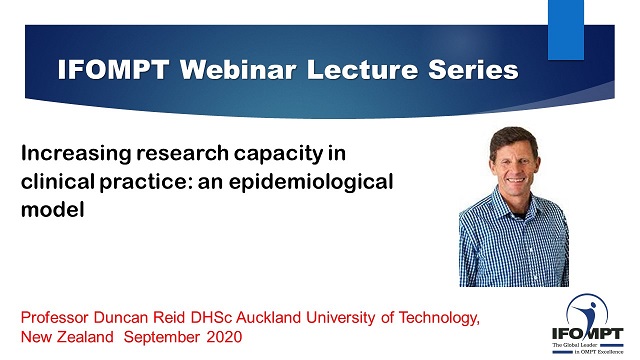 |
Increasing Research Capacity in Clinical Practice- An Epidemiological Model - Prof Duncan Reid It is often stated that there is a disconnect between research that goes on in academic institutions and clinical practice. It is also often stated that clinicians are too busy to engage in research as they have high clinical workloads. Clinicians need research to inform their practice and researchers need clinicians to be able to access patients so they can deliver research that matters. There is a wealth of knowledge sitting in clinical notes that could easily inform research questions or demonstrate important outcomes in clinical practice. One of the challenges to using this type of clinical data is the variability with which data is collected. The aim of this webinar is to provide clinicians with a framework for collecting good epidemiological data in a logical fashion that helps to inform wider questions. This will be based on research undertaken in a sports physiotherapy environment but has wider applicability to musculoskeletal practice. |
Pain Science - Hands-on or Hands-off? - Dr Louie Puentedura Pain Neuroscience Education teaches us that pain comes from the brain, and that pain and injury (tissue damage) are not synonymous. If pain comes from the brain, then why do manual therapy? Doesn’t manual therapy foster dependence upon the provider? Doesn’t it focus on anatomical issues, i.e. the tissues? Can pain neuroscience and manual therapy co-exist? Can manual therapy be a way to give the brain and helping hand? |
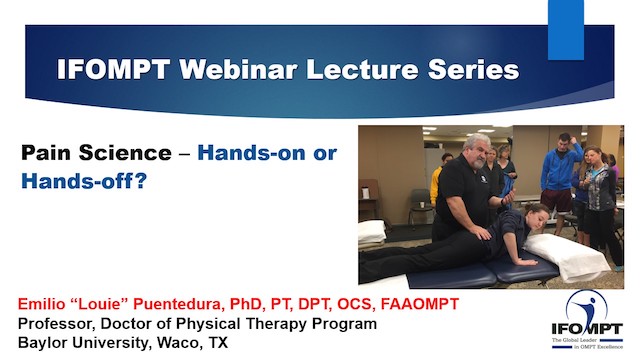
|
Early physiotherapy management of acute whiplash injury: How can we do better?- Prof Michelle Sterling Physiotherapists are the health care provider most commonly involved in the management of acute whiplash injury. Yet traditional physiotherapy treatments of advice, exercise and manual therapy have only small effects with many injured people developing chronic pain and disability despite treatment. Injured people with poor recovery present a complex clinical picture with psychological distress (particularly posttraumatic stress symptoms) and features of nociplastic pain making clinical management challenging. This webinar will outline evident-based risk stratified assessment of people with acute whiplash and how treatment targeting individual risk factors can be integrated into usual physiotherapy care. |
Getting on your Nerves: Clues and Pitfalls when Assessing and Managing Patients with Entrapment Neuropathies - Dr Annina Schmid Patients with entrapment neuropathies such as radiculopathies or carpal tunnel syndrome are frequently seen by physiotherapists. However, diagnosis and treatment often remain challenging. In this webinar, I will incorporate the latest evidence from both clinical and preclinical sciences which have significantly advanced our understanding of the diagnosis and treatment of entrapment neuropathies. Common believes will be challenged and clues and pitfalls in the assessment and management of patients with entrapment neuropathies highlighted. This webinar will help participants to
|
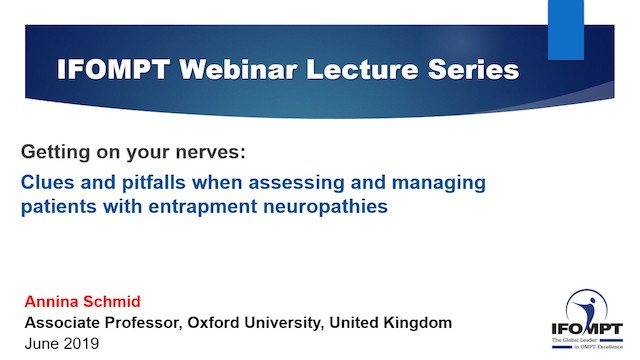  |
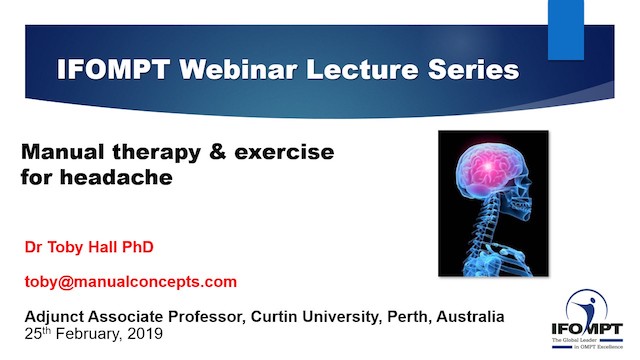  |
Manual Therapy and Exercise for Headache - Dr Toby Hall Headache is a common and debilitating condition, which can be difficult to diagnose and manage as it is both a symptom and a disease. The International Headache Society lists more than 300 different forms of headache, many arising from serious pathology, and clearly not all can be managed through physical intervention such as manual therapy and exercise. However, physical treatments have been shown to be effective in the long-term management of specific headache forms, including cervicogenic and tension-type headache. This seminar clarified evidence-based classification and management of headache suitable for physical treatment including exercise to improve clinical management. |
Non-Specific Neck Pain: The Case for Specific Treatment - Emeritus Prof Gwendolen Jull The burden of neck pain is rising. In recent times, the term non-specific neck pain has been advocated in some quarters in recognition of the difficulty in diagnosing a distinct pathological lesion either in the clinical examination or with current imaging practices. In tandem, generic non-specific management approaches of advice and activity are appearing. In this webinar, it will be argued, based on extensive research, that any prospect of reducing the burden of neck pain for the individual patient requires patient centred, specific care whether the management is, manipulative therapy, therapeutic exercise, education, or behaviour modification. |
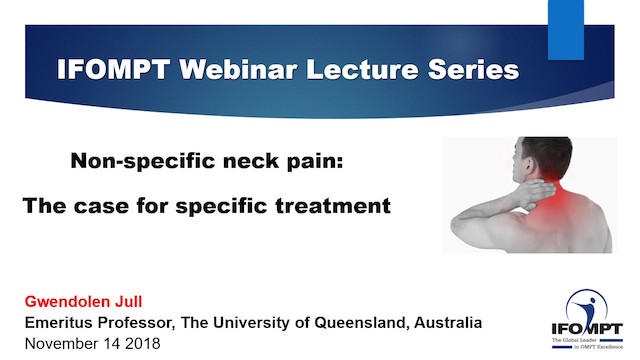  |
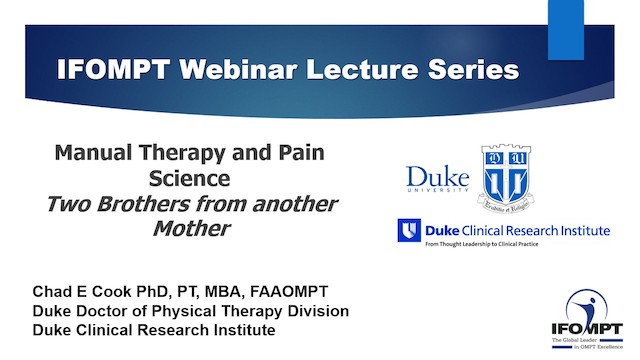  |
Manual Therapy and Pain Science - Two Brothers from Another Mother - Prof Chad Cook Pain Science and Orthopedic Manual Therapy are both intervention methods that are designed to reduce pain and improve global outcomes of patients. Both interventions involve pain modulatory principles and both have been well studied in the literature. Recent social media chatter, clinical opinion, and an occasional publication, have pitted these two intervention methods as opposing constructs. This webinar discusses the key principles of each approach and compares and contrasts. Certainly, the methods are not the same, but interestingly, they have similar genetics that are worth discussion. |